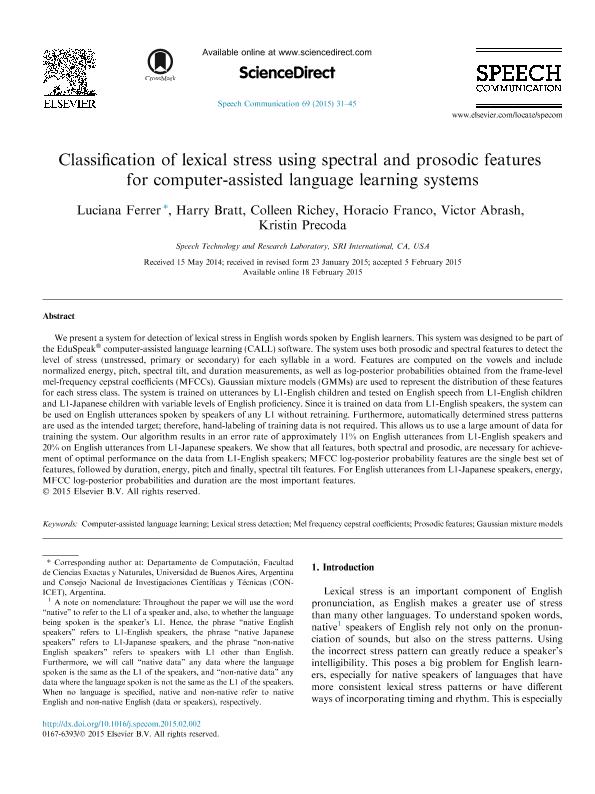Mostrar el registro sencillo del ítem
dc.contributor.author
Ferrer, Luciana

dc.contributor.author
Bratt, Harry
dc.contributor.author
Richey, Colleen
dc.contributor.author
Franco, Horacio
dc.contributor.author
Abrash, Victor
dc.contributor.author
Precoda, Kristin
dc.date.available
2018-03-06T21:32:52Z
dc.date.issued
2015-02
dc.identifier.citation
Ferrer, Luciana; Bratt, Harry; Richey, Colleen; Franco, Horacio; Abrash, Victor; et al.; Classification of lexical stress using spectral and prosodic features for computer-assisted language learning systems; Elsevier Science; Speech Communication; 69; 2-2015; 31-45
dc.identifier.issn
0167-6393
dc.identifier.uri
http://hdl.handle.net/11336/38100
dc.description.abstract
We present a system for detection of lexical stress in English words spoken by English learners. This system was designed to be part of the EduSpeak® computer-assisted language learning (CALL) software. The system uses both prosodic and spectral features to detect the level of stress (unstressed, primary or secondary) for each syllable in a word. Features are computed on the vowels and include normalized energy, pitch, spectral tilt, and duration measurements, as well as log-posterior probabilities obtained from the frame-level mel-frequency cepstral coefficients (MFCCs). Gaussian mixture models (GMMs) are used to represent the distribution of these features for each stress class. The system is trained on utterances by L1-English children and tested on English speech from L1-English children and L1-Japanese children with variable levels of English proficiency. Since it is trained on data from L1-English speakers, the system can be used on English utterances spoken by speakers of any L1 without retraining. Furthermore, automatically determined stress patterns are used as the intended target; therefore, hand-labeling of training data is not required. This allows us to use a large amount of data for training the system. Our algorithm results in an error rate of approximately 11% on English utterances from L1-English speakers and 20% on English utterances from L1-Japanese speakers. We show that all features, both spectral and prosodic, are necessary for achievement of optimal performance on the data from L1-English speakers; MFCC log-posterior probability features are the single best set of features, followed by duration, energy, pitch and finally, spectral tilt features. For English utterances from L1-Japanese speakers, energy, MFCC log-posterior probabilities and duration are the most important features.
dc.format
application/pdf
dc.language.iso
eng
dc.publisher
Elsevier Science

dc.rights
info:eu-repo/semantics/openAccess
dc.rights.uri
https://creativecommons.org/licenses/by-nc-nd/2.5/ar/
dc.subject
Computer-Assisted Language Learning
dc.subject
Gaussian Mixture Models
dc.subject
Lexical Stress Detection
dc.subject
Mel Frequency Cepstral Coefficients
dc.subject
Prosodic Features
dc.subject.classification
Ciencias de la Computación

dc.subject.classification
Ciencias de la Computación e Información

dc.subject.classification
CIENCIAS NATURALES Y EXACTAS

dc.title
Classification of lexical stress using spectral and prosodic features for computer-assisted language learning systems
dc.type
info:eu-repo/semantics/article
dc.type
info:ar-repo/semantics/artículo
dc.type
info:eu-repo/semantics/publishedVersion
dc.date.updated
2018-03-06T17:43:29Z
dc.journal.volume
69
dc.journal.pagination
31-45
dc.journal.pais
Países Bajos

dc.journal.ciudad
Amsterdam
dc.description.fil
Fil: Ferrer, Luciana. Consejo Nacional de Investigaciones Científicas y Técnicas; Argentina. Sri International; Estados Unidos
dc.description.fil
Fil: Bratt, Harry. Sri International; Estados Unidos
dc.description.fil
Fil: Richey, Colleen. Sri International; Estados Unidos
dc.description.fil
Fil: Franco, Horacio. Sri International; Estados Unidos
dc.description.fil
Fil: Abrash, Victor. Sri International; Estados Unidos
dc.description.fil
Fil: Precoda, Kristin. Sri International; Estados Unidos
dc.journal.title
Speech Communication

dc.relation.alternativeid
info:eu-repo/semantics/altIdentifier/url/http://www.sciencedirect.com/science/article/pii/S0167639315000151
dc.relation.alternativeid
info:eu-repo/semantics/altIdentifier/doi/http://dx.doi.org/10.1016/j.specom.2015.02.002
Archivos asociados
